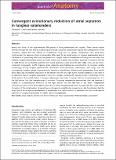| dc.contributor.author | Lewis, Zachary R. | |
| dc.contributor.author | Hanken, James | |
| dc.date.accessioned | 2017-02-10T16:22:53Z | |
| dc.date.issued | 2016 | |
| dc.identifier | Quick submit: 2016-12-02T08:08:07-0500 | |
| dc.identifier.citation | Lewis, Zachary R., and James Hanken. 2016. “Convergent Evolutionary Reduction of Atrial Septation in Lungless Salamanders.” Journal of Anatomy 230 (1) (August 25): 16–29. Portico. doi:10.1111/joa.12535. | en_US |
| dc.identifier.issn | 0021-8782 | en_US |
| dc.identifier.uri | http://nrs.harvard.edu/urn-3:HUL.InstRepos:30208850 | |
| dc.description.abstract | Nearly two thirds of the approximately 700 species of living salamanders are lungless. These species respire entirely through the skin and buccopharyngeal mucosa. Lung loss dramatically impacts the configuration of the circulatory system but the effects of evolutionary lung loss on cardiac morphology have long been controversial. For example, there is presumably little need for an atrial septum in lungless salamanders due to the absence of pulmonary veins and the presence of a single source of mixed blood flowing into the heart, but whether lungless salamanders possess an atrial septum and whether the sinoatrial aperture is located in the left or right atrium are unresolved; authors have stated opposing claims since the late 1800s. Here, we use microcomputed tomography (l-CT) imaging, gross dissection and histological reconstruction to compare cardiac morphology among lungless plethodontid salamanders (Plethodontidae), salamanders with lungs, and the convergently lungless species Onychodactylus japonicus (Hynobiidae). Plethodontid salamanders have partial atrial septa and incomplete separation of the atrium into left and right halves. Partial septation is also seen in O. japonicus. Hence, lungless salamanders from two lineages convergently evolved similar morphology of the atrial septum. The partial septum in lungless salamanders can make it appear that the sinoatrial aperture is in the left atrium, but this interpretation is incorrect. Outgroup comparisons demonstrate that the aperture is located in a posterodorsal extension of the right atrium into the left side of the heart. Independent evolutionary losses of the atrial septum may have a similar developmental basis. In mammals, the lungs induce formation of the atrial septum by secreting morphogens to neighboring mesenchyme. We hypothesize that the lungs induce atrial septum development in amphibians in a similar fashion to mammals, and that atrial septum reduction in lungless salamanders is a direct result of lunglessness. | en_US |
| dc.description.sponsorship | Organismic and Evolutionary Biology | en_US |
| dc.language.iso | en_US | en_US |
| dc.publisher | Wiley-Blackwell | en_US |
| dc.relation.isversionof | doi:10.1111/joa.12535 | en_US |
| dc.relation.hasversion | https://www.ncbi.nlm.nih.gov/pubmed/27558020 | en_US |
| dash.license | LAA | |
| dc.subject | atrial septum | en_US |
| dc.subject | axolotl | en_US |
| dc.subject | evo-devo | en_US |
| dc.subject | homoplasy | en_US |
| dc.subject | lung | en_US |
| dc.subject | lunglessness | en_US |
| dc.subject | Plethodontidae | en_US |
| dc.subject | salamander | en_US |
| dc.title | Convergent evolutionary reduction of atrial septation in lungless salamanders | en_US |
| dc.type | Journal Article | en_US |
| dc.date.updated | 2016-12-02T13:08:08Z | |
| dc.description.version | Version of Record | en_US |
| dc.relation.journal | Journal of Anatomy | en_US |
| dash.depositing.author | Hanken, James | |
| dc.date.available | 2016 | |
| dc.date.available | 2017-02-10T16:22:53Z | |
| dc.identifier.doi | 10.1111/joa.12535 | * |
| dash.contributor.affiliated | Hanken, James | |


